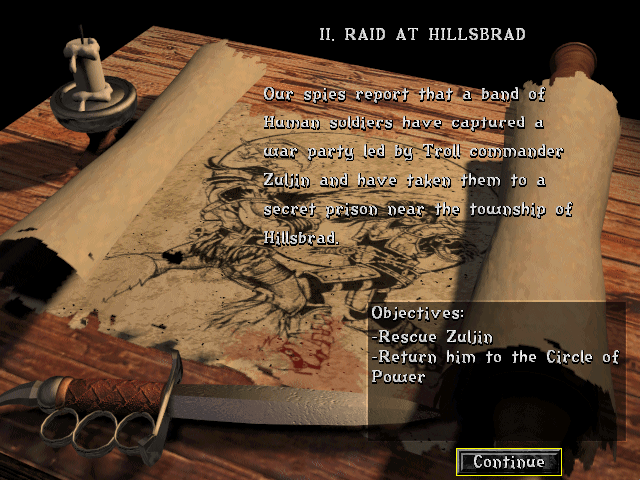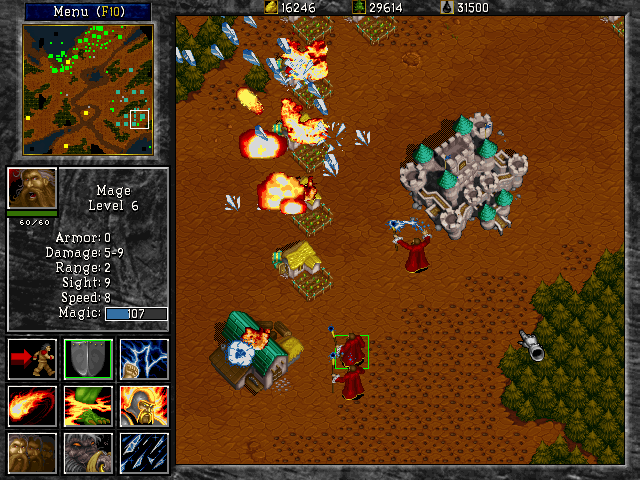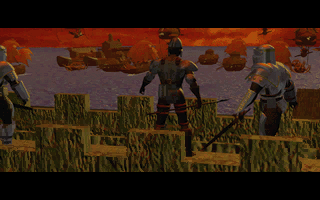Retro Replay Review
Gameplay
WarCraft II: Tides of Darkness builds on the foundational real-time strategy mechanics established in its predecessor, offering a deeper and more varied strategic experience. Players must gather resources—gold, lumber, and oil—to construct bases, recruit units, and research upgrades. The introduction of naval and aerial combat layers new tactical dimensions onto the familiar land-based warfare, forcing commanders to think in three dimensions rather than two.
(HEY YOU!! We hope you enjoy! We try not to run ads. So basically, this is a very expensive hobby running this site. Please consider joining us for updates, forums, and more. Network w/ us to make some cash or friends while retro gaming, and you can win some free retro games for posting. Okay, carry on 👍)
The campaign mode is split between the human-led Alliance and the marauding Orcish Horde, each with its own unique roster of units and structures. Missions range from straightforward base assaults to complex amphibious landings and cliffside skirmishes, keeping the pacing brisk and the objectives varied. The inclusion of a scenario editor further extends replay value by empowering players to craft custom maps and objectives, fostering creativity and community-driven content.
Multiplayer support for up to eight players stands out as one of WarCraft II’s most compelling features. Whether connected via LAN or modem, alliances can be forged and broken on the fly, alliances can be tested, and the balance of power constantly shifts. Despite its DOS-based origins, the game handles multiplayer sessions smoothly, ensuring that epic sea battles and high-flying dragon raids remain lag-free and exhilarating.
Graphics
Transitioning to SVGA at 640×480 resolution, WarCraft II delivers a dramatic visual leap over the chunky EGA graphics of the original. Units and buildings are richly detailed, with distinctive color palettes for each faction—Orcs are bathed in earthy browns and greens, while the Alliance pops with glimmering blues and silvers. The varied terrain tilesets (forests, swamps, tundra, desert) add both aesthetic diversity and strategic depth.
Animations are smoother and more expressive, from the Orcish catapults rocking under the weight of a boulder to the dwarven cannons puffing clouds of black smoke with every shot. Water effects in naval battles shimmer convincingly under different weather conditions, and flying units cast dynamic shadows that cleverly convey altitude changes. Even the user interface enjoys a facelift, with clearer icons and more intuitive menus that streamline base management.
Cutscenes between missions employ a blend of prerendered art and in-engine cinematics, painting grand vistas of war-torn realms and imposing war machines. Though modest by today’s standards, these interludes immerse players in the escalating conflict and raise the stakes before each new operation. The Red Book CD audio soundtrack adds further polish, delivering stirring orchestral and choral themes that elevate the onscreen action.
Story
Set on the high-fantasy world of Azeroth, WarCraft II picks up after the devastation of the first war, during which the Orcish Horde overran the kingdom of Azeroth. Now on the brink of another cataclysmic invasion, the orcs set their sights on Lordaeron, poised to crush human, elven, and dwarven realms alike. In response, disparate races forge the Alliance of Lordaeron in a desperate bid to repel the green tide.
The narrative unfolds through mission briefings, cutscenes, and scrapbook-style journal entries, painting a sweeping tale of heroism, betrayal, and political intrigue. Key figures such as Admiral Daelin Proudmoore and Warchief Orgrim Doomhammer emerge as towering personalities, shaping the direction of the war and providing memorable focal points for each campaign arc. Subplots involving espionage, blockade-running, and raids behind enemy lines enrich the overarching storyline.
While the plot adheres to classic fantasy tropes—epic battles between good and evil, noble sacrifices, the rise of dark champions—it crafts a cohesive, engaging framework for the strategic gameplay. Each mission feels like a chapter in an unfolding legend, and even routine resource-gathering tasks carry emotional weight when framed as vital steps in a larger struggle for survival.
Overall Experience
WarCraft II: Tides of Darkness remains a benchmark in real-time strategy design, blending accessible mechanics with deep strategic layers. The dual campaigns encourage players to master both factions’ strengths and weaknesses, while the scenario editor and multiplayer modes ensure nearly limitless replayability. Even decades after its release, the game retains a timeless charm that continues to captivate strategy enthusiasts.
The audiovisual package—complete with SVGA graphics, cinematic cutscenes, and a sweeping CD-quality soundtrack—still resonates today, delivering moments of genuine dramatic flair. Whether you’re maneuvering a fleet of battleships to secure a coastal pass or directing dragons to rain fire on enemy fortresses, the spectacle never grows old. The balance between macro-level economy management and micro-level tactical control strikes a satisfying equilibrium for both casual and hardcore players.
For anyone seeking a challenging yet approachable RTS packed with content, WarCraft II stands the test of time. Its blend of lore-rich storytelling, varied mission design, and robust multiplayer functionality makes it a must-own title for fans of the genre. The legacy of Tides of Darkness endures not only in the countless hours of enjoyment it provides but also in how it laid the groundwork for modern real-time strategy masterpieces.
 Retro Replay Retro Replay gaming reviews, news, emulation, geek stuff and more!
Retro Replay Retro Replay gaming reviews, news, emulation, geek stuff and more!









Reviews
There are no reviews yet.